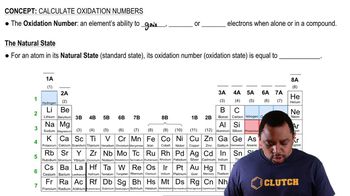Here are the essential concepts you must grasp in order to answer the question correctly.
Oxidation Numbers
Oxidation numbers are a way to keep track of electrons in chemical compounds. They indicate the degree of oxidation of an atom in a molecule, helping to identify how many electrons an atom has gained, lost, or shared. The rules for assigning oxidation numbers include that the oxidation number of an element in its elemental form is zero, and for monoatomic ions, it equals the charge of the ion.
Recommended video:
Rules for Assigning Oxidation Numbers
There are specific rules for assigning oxidation numbers, such as hydrogen typically having an oxidation number of +1, oxygen usually being -2, and the sum of oxidation numbers in a neutral compound being zero. In polyatomic ions, the sum of the oxidation numbers must equal the charge of the ion. Understanding these rules is essential for accurately determining oxidation states in compounds.
Recommended video:
Thiosulfate Ion (S2O3 2-)
The thiosulfate ion (S2O3 2-) consists of two sulfur atoms and three oxygen atoms, with an overall charge of -2. In this ion, one sulfur atom typically has a lower oxidation state than the other due to its bonding with oxygen. Analyzing the structure and applying oxidation number rules allows for the determination of the oxidation states of sulfur and oxygen within the ion.
Recommended video:

 Verified step by step guidance
Verified step by step guidance


